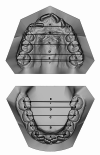Predictability of expansion movements performed by clear aligners in mixed dentition in both arches: a retrospective study on digital casts
- PMID: 38879479
- PMCID: PMC11179342
- DOI: 10.1186/s12903-024-04435-y
Predictability of expansion movements performed by clear aligners in mixed dentition in both arches: a retrospective study on digital casts
Abstract
Background: to evaluate the predictability of expansion achieved in patients in early mixed dentition treated with Clear Aligners (CA), analyzing the efficiency of the expansion at the end of the first set of aligners and at the end of the therapy in the upper and lower arch.
Methods: 36 patients (20 F, 16 M; mean age 8.3 ± 1.5 years) were selected retrospectively from the Department of Orthodontics of the Hospital of Rome "Tor Vergata". All subjects were treated with CA with no other auxiliaries than attachments. For each patient a standardized sequential expansion protocol was planned for both arches. Digital dental casts were created at three observation periods from an intraoral scanner: prior to treatment (T0), at the end of the first set of aligners (T1), at the end of treatment (T2). The 3D models in planned position determined by the first Clincheck (CC) were obtained for comparison with T1 and T2. Six linear transversal measurements were used to evaluate the dimensional changes and the predictability of expansion movements, comparing T1-CC and T2-CC.
Results: a statistically significant increase within the pre-treatment and the final outcomes for all the variables examined was found. In the upper arch, the greatest level of predictability was detected at the level of the first (46.44%) and second deciduous molar width (44.95%) at T1. The analysis of T2-CC changes showed a significant increase in the percentage of predictability of expansion at the level of the first permanent molars, at mesial (54.86%) and distal (58.92%) width. In the lower arch, a higher percentage of predictability than the upper arch was reported at T1-CC and T2-CC, with the greatest values at the level of second (T1-CC: 48.70%; T2-CC: 75.32%) and first deciduous molar width (T1-CC: 45.71%; T2-CC: 72.75%).
Conclusions: CA can induce significant transversal increments. The predictability of expansion is variable, but it did not exceed the 50% during the first set of aligners. It was necessary to apply refinement set to achieve a good predictability for expansion of about 70%. The expansion in the lower arch was observed to be more predictable than in the upper arch.
Keywords: Clear aligner; Digital dental casts; Interceptive treatment; Mandibular expansion; Maxillary expansion; Mixed dentition; Predictability; Transversal changes.
© 2024. The Author(s).
Conflict of interest statement
The authors report a funding relationship between themselves and Align Technology. However, Align Technology had no role in the design of the study, in the collection, analyses or interpretation of data, in the writing of the manuscript, or in the decision to publish the results.
Figures



Similar articles
-
Maxillary arch development with Invisalign system.Angle Orthod. 2021 Jul 1;91(4):433-440. doi: 10.2319/080520-687.1. Angle Orthod. 2021. PMID: 33570617 Free PMC article.
-
Factors affecting expansion predictability of clear aligner treatment.Clin Oral Investig. 2025 Apr 21;29(5):257. doi: 10.1007/s00784-025-06328-y. Clin Oral Investig. 2025. PMID: 40257582 Free PMC article.
-
A long-term evaluation of the mandibular Schwarz appliance and the acrylic splint expander in early mixed dentition patients.Am J Orthod Dentofacial Orthop. 2006 Aug;130(2):202-13. doi: 10.1016/j.ajodo.2004.12.023. Am J Orthod Dentofacial Orthop. 2006. PMID: 16905065 Clinical Trial.
-
Effectiveness of dental arch expansion in the orthodontic treatment with clear aligners: a scoping review.Eur J Orthod. 2024 Dec 1;46(6):cjae059. doi: 10.1093/ejo/cjae059. Eur J Orthod. 2024. PMID: 39449616
-
Efficiency of Invisalign First® to promote expansion movement in mixed dentition: a retrospective study and systematic review.Eur J Paediatr Dent. 2023 Jun 9;24(2):112-123. doi: 10.23804/ejpd.2023.1754. Eur J Paediatr Dent. 2023. PMID: 37038757
Cited by
-
Artificial Intelligence in Aesthetic Dentistry: Is Treatment with Aligners Clinically Realistic?J Clin Med. 2024 Oct 12;13(20):6074. doi: 10.3390/jcm13206074. J Clin Med. 2024. PMID: 39458024 Free PMC article.
-
Clinical Effectiveness of Clear Aligner Therapy During Interceptive Orthodontic Treatment in Adolescent Patients: A Systematic Review and Meta-Analysis.Cureus. 2025 Jul 17;17(7):e88157. doi: 10.7759/cureus.88157. eCollection 2025 Jul. Cureus. 2025. PMID: 40821259 Free PMC article. Review.
References
Publication types
MeSH terms
LinkOut - more resources
Full Text Sources

